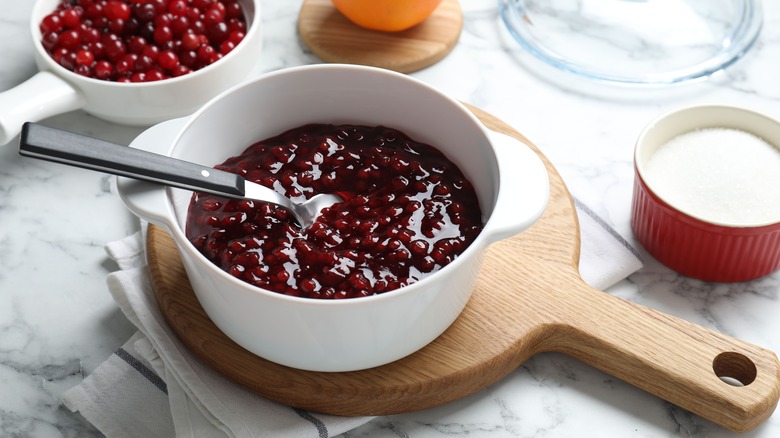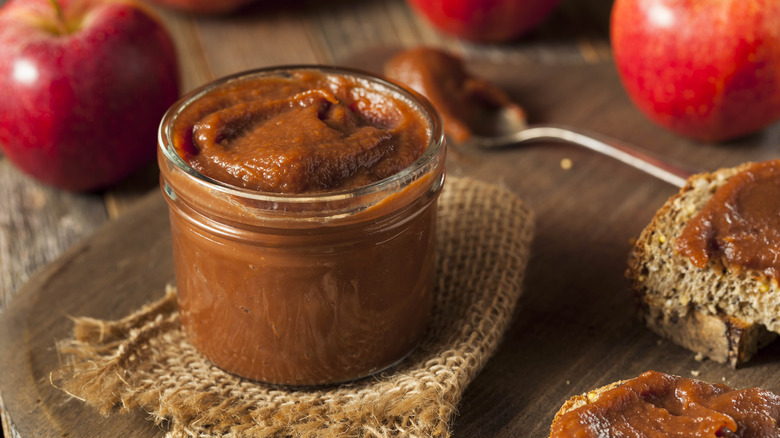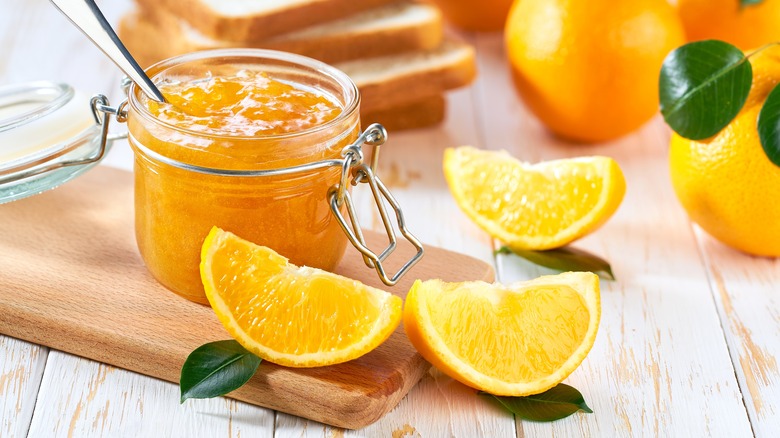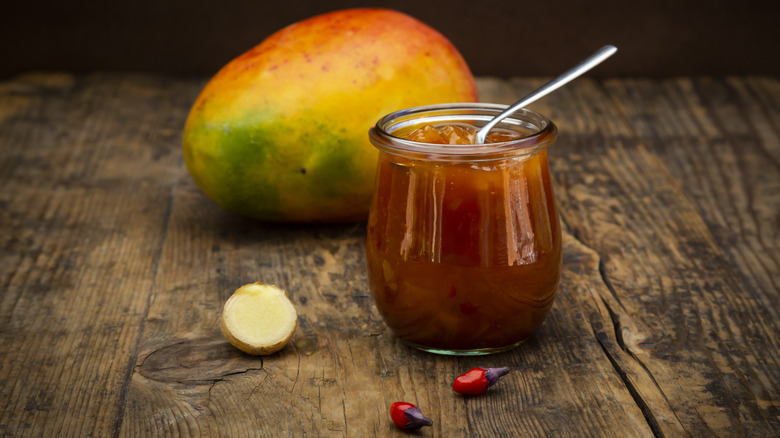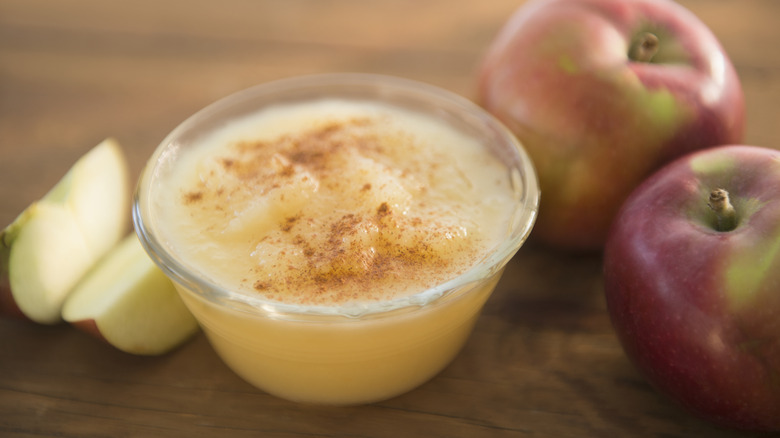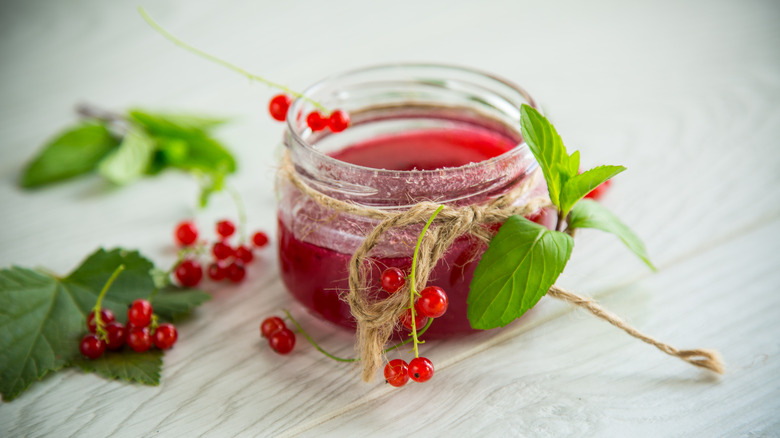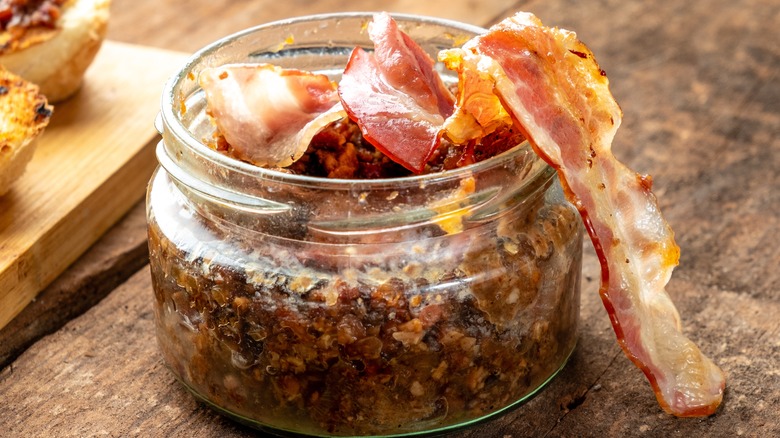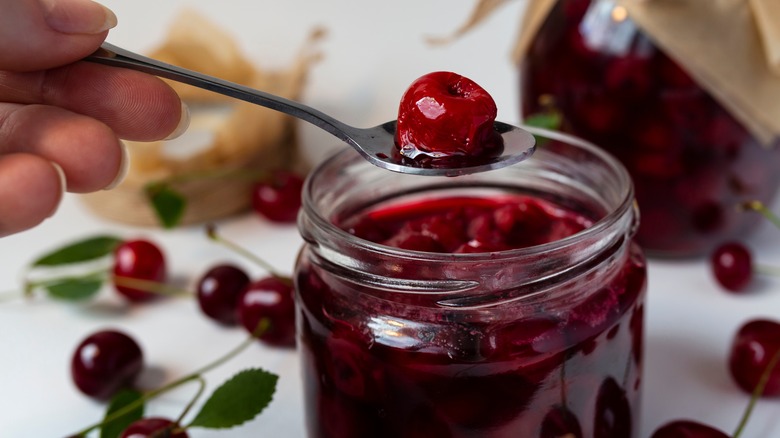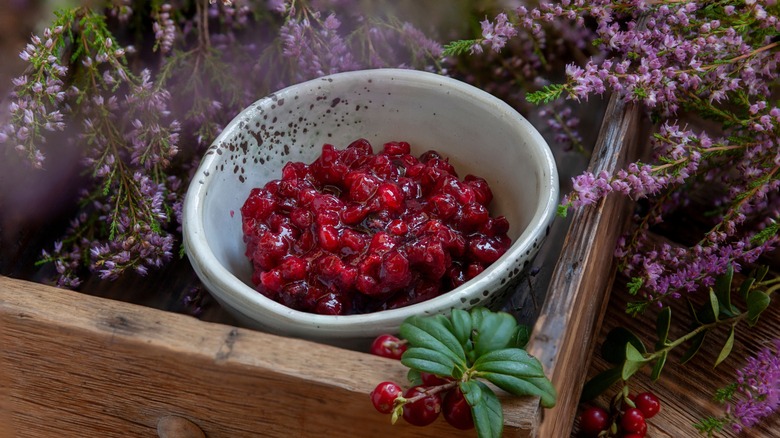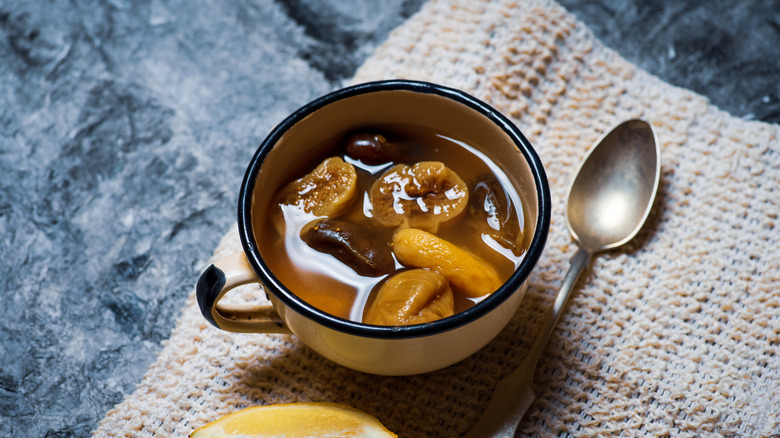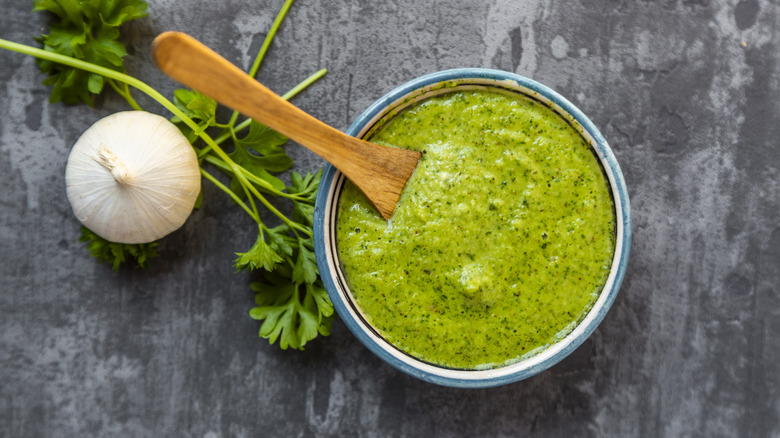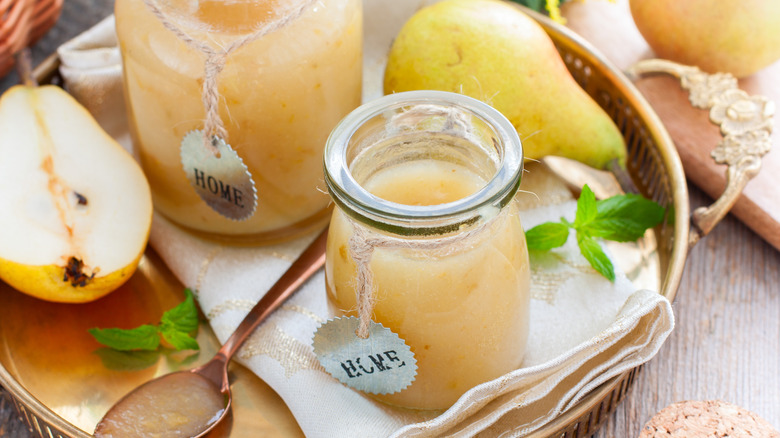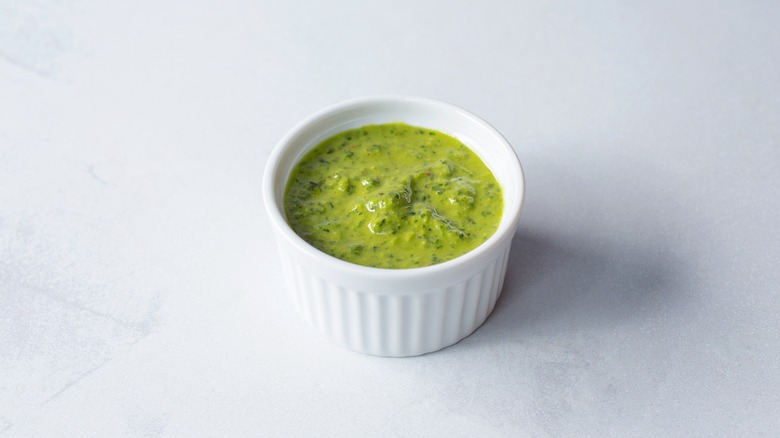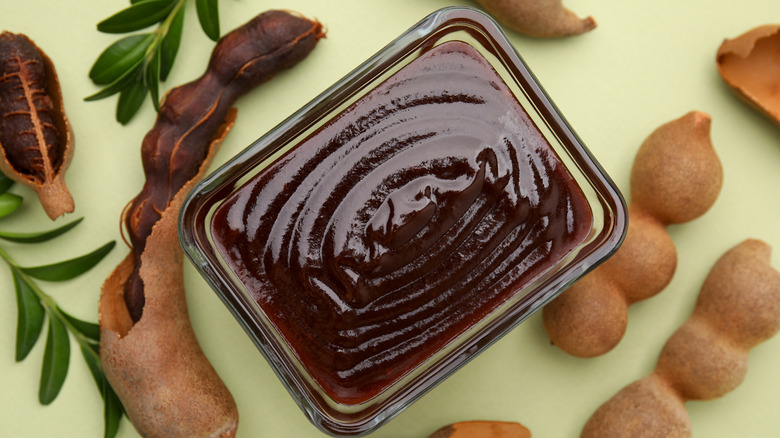If You Don't Like Cranberry Sauce, Try These Alternatives At Thanksgiving Instead
Cranberry sauce: Everyone loves it. Or do they? This side dish is a Thanksgiving staple, but for a lot of people it just doesn't hit the spot. Cranberry sauce can be a hit-and-miss affair — for some, it's way too tart and acidic, whereas others find it to be cloyingly sweet and syrupy. Other people find that cranberry sauce is just a little lacking in distinct flavor to make it a worthy part of such an iconic meal, and view it as an unnecessary addition that just takes up space.
It's worth remembering, though, that cranberry sauce has a specific and important function in a Thanksgiving meal. It provides both sweetness and moisture, which contrasts and complements the savory (and sometimes dry) turkey. So, how do you keep that function while making things more interesting? The key is to replace it entirely with a more exciting alternative. There are dozens of sauces, jams, chutneys, and spreads out there that can effectively replace cranberry sauce at Thanksgiving, which go seamlessly with the other items on the table while offering just a little bit more flavor. From bacon-infused jams to spicy fruit chutneys, we've got every alternative you'll need right here.
Apple butter
Cranberry sauce amps up Thanksgiving dinner with its tangy sweetness, and so ideally you'll want any alternatives you use to supply the same flavor notes. Enter apple butter, an amped-up form of applesauce that provides sweet and sour notes to your meal. Although butter's in the name, there's no fat to be seen in most apple butter recipes. Instead, it gets its smoothness from being simmered slowly, which breaks the apples down, turning them into a jammy, luscious consistency.
Apple butter has a slight natural sharpness that's made even more pronounced by adding apple cider vinegar, but it doesn't have the same insistent flavor that cranberry sauce does. Instead, it provides a slightly more mellow sweetness and sourness. As such, it's ideal for folks who still want a sugary pop on their plate, but don't want their turkey overwhelmed. It's given extra complexity from cinnamon and pumpkin pie spice, infusing it with peppery, aromatic warmth that will fill you with holiday cheer. The vanilla extract in the recipe, meanwhile, gives it further depth. The best part is that making apple butter is a great way to get through all of those apples you said you'd snack on — simply turn them into a delicious condiment instead.
Orange marmalade
If cranberry sauce isn't your thing, orange marmalade will scratch the same itch. Orange marmalade has a balance of sweetness and acidity that matches cranberry sauce perfectly, and its vibrant orange hue brings a lot of color to your plate. Importantly though, it has a little more going for it than that. Marmalade differs from jam thanks to the inclusion of fruit peel in its recipe (which is partly why you don't normally see orange or lemon jams in the store). The oils in the peel infuse with the other elements, giving the marmalade a deep, citrusy aroma that brightens up the heavy flavors of Thanksgiving dinner.
Importantly, orange marmalade has a bitter note in it that isn't present in jam, nor in sweeter cranberry sauces. It's important to remember that adding too much of it can therefore overwhelm your meal. Resist the temptation to throw a lot of orange marmalade onto your plate, and just add a teaspoon at a time. Plus, you don't have to stop at orange. Other citrus marmalades, like lemon and grapefruit, can bring their own dynamism to the table and deliver even more sharpness.
Fruit chutney
Cranberry sauce can be a little one-note. This is particularly the case when it comes to store-bought varieties, which can lean heavily on sweetness at the expense of any spicy warmth and complexity. That's where fruit chutney comes in. Fruit chutney is a natural fit with savory meats: Not only does it give dishes like beef stew a flavor boost, but it also pairs well with white meats like turkey. It's all down to its combination of sweetness and spice, with the sweetness balancing out the umami tones of the meat and the spice making everything so much more dynamic and well-rounded.
Although most fruit chutneys will work with turkey, there are a few out there that'll work especially well. For sweeter notes, go for mango chutney, which gives you a burst of sugar and sharpness that mirrors cranberry sauce, with an undertone of cumin, coriander, and cardamom. Pear chutney will also work excellently, with the slightly milder flavor of the fruit slipping into a Thanksgiving meal seamlessly. If you want something slightly deeper, a plum chutney will give your meal deeper notes, as well as a gorgeous deep color that emulates cranberry sauce.
Applesauce
If you're looking for an alternative to cranberry sauce that doesn't require you to hunt high and low, then applesauce is where it's at. Most people have a jar of it sitting somewhere in their fridge, and it hits many of the same flavor notes as cranberry sauce. Where applesauce differs, though, is in its mildness. It has a much more gentle flavor than cranberry sauce, which can often overwhelm the senses with its bitter and sour taste. Its milder tones makes it a better choice for young ones around the Thanksgiving table, too.
There's no need to stick to store-bought applesauce here, though. Making your own is a breeze, and requires little more than apples, sugar, water, and a touch of cinnamon. It's worth bearing in mind, however, that your choice of apples is important. You'll want to go for a firm fruit that has your preferred balance of sweetness to tartness. If you like a sweeter sauce, Fuji and Golden Delicious apples are a great choice, with the latter being slightly less sugary. For a tarter taste, go for a McIntosh or a Cortland apple. You don't have to stick with one apple, either: A combination of a few different kinds will give your applesauce complexity.
Red currant jelly
You can't underestimate the impact that cranberry sauce has at a Thanksgiving table, and that impact isn't necessarily down to its taste. Cranberry sauce gives your meal a pleasing splash of deep red that brightens up the beige tones that dominate your plate. If you're looking for this visual effect without the distinctive taste of cranberry sauce, red currant jelly is the next best thing. It is a natural fit for pairing with meat and other savory elements, and it has a zesty flavor that's similar to cranberry sauce without its insistent tang.
Though high in pectin, red currant jelly is generally slightly thinner than cranberry sauce, so it doesn't have that jelly-like consistency that can make the classic condiment so unappealing. This can make it slightly easier to spread onto your food, and it serves more as a flavor enhancer.
Bacon jam
If you want a replacement for cranberry sauce that sings with savoriness while simultaneously hitting those sweet notes, break out the bacon jam. Bacon jam is, as you might expect, made by simmering diced bacon with brown sugar and other sweeteners like maple syrup, alongside aromatics like onion, garlic, and thyme. The result is a sweet spread that has a massive amount of umami, which pairs perfectly with white meats that can sometimes lack a little flavor (no shade to turkey here, but ... yeah, if not done properly, it can be pretty tasteless, and we all know it).
Bacon jam also hits the visual impact that you get from cranberry sauce. When cooked, it turns a deep red-brown, which glistens thanks to the bacon fat in the recipe. It's worth bearing in mind that bacon jam doesn't really have the fruity notes that cranberry sauce has, and it's a pretty big swap in terms of flavor. It can also be incredibly salty if you pick a bacon brand that's higher in sodium, so it's always a good idea to err on the side of caution when adding salt to your recipe. Bear in mind that whatever salt you add will be concentrated by the simmering process, too.
Cherry gastrique
Most cultures have dishes and condiments that embrace sweet-sour flavor combos, and it's this balance that makes cranberry sauce so appealing. In France, though, they opt for a different kind of sauce. Gastrique is a version of sweet and sour sauce that in its most basic form is made from a combination of caramelized sugar and vinegar. The infusion of the two makes a sharp, sprightly sauce that's given unexpected depth from the caramelization process, and the choice of vinegar makes a big difference to the final flavor.
Gastriques can be given even more pop with additional ingredients, which take the sauce to the next level — and that's where cherries come in. Making cherry gastrique is as simple as cooking your chosen cherries with sugar and vinegar until they break down into an unctuous, jammy consistency. The result is a cranberry sauce substitute that's full of the deep, brassy flavors of cherries, but with a sourness that's much bolder than the standard Thanksgiving condiment. Adding a dash of cherry vinegar to the gastrique can make the flavors even bolder.
Lingonberry jam
Move over, cranberries, there's a new berry in town. The humble lingonberry looks very similar to a cranberry, with the same bright-red color and small, round shape. Their flavors are subtly different, though, as are the condiments that are made from them. Lingonberries have a slightly sweeter flavor profile, and while they have a healthy amount of acidity, lingonberry jam tends to have a subtler taste than cranberry sauce. It's a great choice if you want a cranberry sauce substitute that's just a little gentler on the palette.
Lingonberry jam has a good lineage of being paired with meats, as anyone who's been to the IKEA cafe recently can confirm. It's traditional to serve Swedish meatballs with a generous spoonful of the jam, where it offsets their savory, salty flavors. Its ability to boost slightly darker meats makes it a great choice to pair with any sausage stuffing you're making, and it'll also go perfectly with glazed ham. Don't write it off for your turkey, though: It'll do a great job of keeping it moist and bright.
Fig compote
One thing that cranberry sauce can lack is nuance. Whether you're buying it in a can or making it at home, it can end up being sweet enough to make your teeth ache, and have very little resemblance to the fruit that it came from. So for folks who want a condiment that actually has fruity flavors in it while still being sweet and spreadable, fig compote is where it's at. You can think of a compote as a kind of chunky jam, with the spread combining fruit chunks and syrup and simmering the two until the fruit has softened, but still has a bite to it. Compotes tend to have slightly less sugar than jam, but fig compote is imbued with the natural sweetness and squidginess of the fruit.
That very squidginess also gives fig compote a more satisfying mouthfeel than cranberry sauce, which can often be jelly-like and kinda unpleasant. The best part is that fig compote is incredibly easy to make. All you need are three ingredients (figs, sugar, and a lemon), combined and simmered together. Remember, though, that fig compote won't preserve in the same way that jam or some store-bought cranberry sauces might, so make sure you don't make it too far in advance.
Chimichurri
It's all very well and good opting for a jam, chutney, or marmalade as a cranberry sauce alternative, but what if you want something completely different? Well, folks, we have the option for you. Chimichurri sauce is a bold, vibrant option that not only pairs well with meats, but is a total breeze to make. It has its origins in Argentinian cuisine, and is made by blitzing parsley, cilantro, and garlic with olive oil and lemon juice. The result is an ultra-fresh condiment that brings serious brightness to a Thanksgiving plate.
Trust us when we say that chimichurri's herbal notes liven up your meal significantly. Think about it: The typical Thanksgiving plate is dominated by dense, heavy items that have been drenched in fat and roasted. The meal needs something to offset all of these deep flavors, which is cranberry sauce's function. Chimichurri does this in an entirely different way, and instead of providing overpowering levels of sugar and acidity, it provides pepperiness and freshness from the parsley, oregano, and garlic. It's also a great alternative to make when your cooktop space is limited, as there's no heat required to whip it up. All you do is blend the ingredients together, pour the chimichurri into a bowl, and pop it on the table.
Mostarda
Mostarda is a cranberry sauce alternative with a difference. This Italian condiment is commonly paired with grilled meats, but works just as well with turkey and ham on a Thanksgiving plate. As you can probably guess from its name, mostarda is related to mustard, with the word translating to "mustard" from Italian. However, it is also a more complex condiment that contains mustard alongside dried and fresh fruit, spices, sugar, and vinegar. When the ingredients are all simmered together, they turn into a deeply-flavored condiment with a distinctive tanginess that makes drier cuts of white meat way more appealing.
Mostarda can be made with pretty much any fruit that comes in dried form. Peach, fig, and apricot mostardas are both popular and simple, and would be an excellent cranberry sauce substitute. Peach and apricot mostardas are particularly good if you want to emulate the tartness of cranberry sauce with a bit more depth. If you're a fan of cranberries but not the classic sauce they form, you can even make cranberry mostarda. Just remember that even a bit too much mustard can transform this condiment into a spread that stings your nose and makes your eyes water, so only add a small amount to start.
Pear ketchup
Swapping cranberry sauce for ketchup? It can be done, folks. We're not talking about the classic condiment here, though, but a far more elegant version. While ketchup now is invariably tomato-based, the earliest forms of the condiment didn't contain any tomatoes at all. Incredibly, the sauce used to be primarily made with mushrooms, which were aged, simmered, and then infused with spices.
Over the years, though, ketchup has also referred to fruit or vegetable-based sauces that have been spiked with vinegar, which is where pear ketchup comes in. This curious condiment is simple to make and pairs (get it?) the subtle sweetness of pears with brown sugar and acid to make a cranberry sauce alternative that feels fresh and innovative. You can also use other types of fruits to make ketchups, like plums or blackberries, which will give it a crisp tanginess that's reminiscent of cranberry sauce without being too close.
Zhoug
We're big fans of subbing cranberry sauce for a herbal alternative, and for all of you spice lovers out there, zhoug's where it's at. Zhoug is a Yemeni condiment that's popular across the Middle East and is close in flavor to chimichurri. Where it differs, though, is in its heat. Zhoug is typically made with a hearty handful of chile peppers, which bring freshness, tartness, and a serious dose of fire. This heat is contributed to by ground and whole spices and aromatics like garlic, with the whole thing tied together by cilantro, the condiment's base ingredient. The result is a sauce unlike anything else you'll have at Thanksgiving, and one that you'll return to year after year.
It's simple enough to make zhoug at home, but if you don't have the energy to hunt for all the fresh ingredients you need the day before Thanksgiving (and would we blame you? No we wouldn't), one store has you covered. Trader Joe's zhoug sauce is just a couple bucks, and its bright-green tones will make any Thanksgiving table so much brighter.
Tamarind compote
We love finding alternative ways of creating familiar flavor palettes. When it comes to cranberry sauce, no way is as exciting as using tamarind. Tamarind is a tart fruit that's particularly popular in Thai cuisine, and its sweet-sour flavor is an essential component of pad Thai and many other classic dishes. It is generally sold in a thick paste in specialty food stores, although it can also be found in block form.
You likely won't want to use tamarind paste or solid tamarind on its own, though — instead, throw it into a compote. Cooking tamarind pulp with brown sugar and a little bit of salt produces a sweet and sour sauce that has a touch more brininess than cranberry sauce, and is guaranteed to make your Thanksgiving way more interesting. If you want to make your tamarind compote even more punchy, you can mix in some chili flakes to give it slightly more heat. Just bear in mind, though, that it can be somewhat of an acquired taste, and so for folks who are unfamiliar with the fruit's flavor, just add a tiny bit to their plates.
